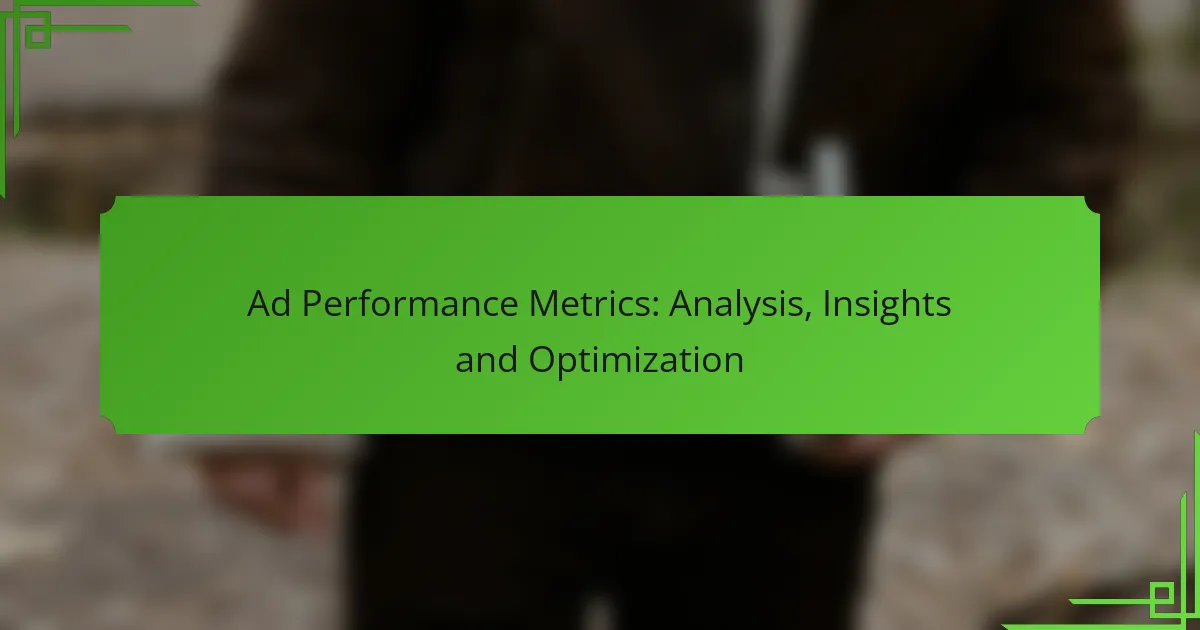Analyzing ad performance metrics is crucial for optimizing advertising strategies and maximizing returns. By focusing on key indicators such as click-through rates, conversion rates, and return on ad spend, marketers can gain valuable insights into campaign effectiveness. Continuous monitoring and refinement of these metrics enable informed decision-making that enhances engagement and drives better results.

How to analyze ad performance metrics effectively?
To analyze ad performance metrics effectively, focus on key indicators such as click-through rates, conversion rates, and return on ad spend. Understanding these metrics allows for informed decisions that can enhance ad strategies and optimize budget allocation.
Utilize Google Analytics for tracking
Google Analytics is a powerful tool for tracking ad performance metrics. It provides insights into user behavior, traffic sources, and conversion data, allowing marketers to assess the effectiveness of their campaigns. Set up goals and funnels to monitor specific actions taken by users after clicking on ads.
Ensure you link your Google Ads account to Google Analytics for a comprehensive view of your ad performance. This integration helps in analyzing user engagement and identifying which ads drive the most valuable traffic.
Implement A/B testing for insights
A/B testing involves comparing two versions of an ad to determine which performs better. By changing one variable at a time, such as the ad copy or call-to-action, you can gain insights into what resonates more with your audience. Aim for a statistically significant sample size to ensure reliable results.
Use A/B testing to refine your ad strategies continuously. For example, if one ad version leads to a higher conversion rate, consider adopting its elements in future campaigns while phasing out less effective variations.
Leverage Facebook Ads Manager for data
Facebook Ads Manager offers detailed analytics on ad performance across various metrics, including reach, engagement, and conversion rates. This platform allows you to segment data by demographics, interests, and behaviors, providing a clearer picture of your target audience’s response to your ads.
Regularly review the performance of your ads in Facebook Ads Manager to identify trends and adjust your strategies accordingly. Utilize the breakdown features to see how different audience segments interact with your ads, which can inform future targeting decisions.
Use conversion tracking tools
Conversion tracking tools are essential for measuring the effectiveness of your ads in driving desired actions, such as purchases or sign-ups. Implement tracking pixels or tags on your website to capture data on user interactions post-click. This data helps in calculating return on investment and optimizing ad spend.
Consider using tools like Google Tag Manager for easier management of tracking codes. Ensure that your tracking setup is accurate to avoid discrepancies in reported conversions, which can lead to misguided ad strategies.

What are the key ad performance metrics to monitor?
Key ad performance metrics to monitor include click-through rate (CTR), cost per acquisition (CPA), return on ad spend (ROAS), and impressions and reach. These metrics provide insights into the effectiveness of your advertising campaigns and help guide optimization efforts.
Click-through rate (CTR)
Click-through rate (CTR) measures the percentage of users who click on an ad after seeing it. A higher CTR indicates that your ad is engaging and relevant to the audience. Generally, a CTR above 2% is considered good, but this can vary by industry.
To improve CTR, focus on creating compelling ad copy and visuals that resonate with your target audience. A/B testing different headlines and calls to action can help identify what works best.
Cost per acquisition (CPA)
Cost per acquisition (CPA) calculates the total cost of acquiring a customer through your advertising efforts. This metric helps determine the profitability of your campaigns. A lower CPA is preferable, indicating that you are spending efficiently to gain customers.
To optimize CPA, analyze your ad spend and conversion rates. Consider adjusting your targeting or bidding strategies to reduce costs while maintaining quality leads. Aim for a CPA that aligns with your profit margins.
Return on ad spend (ROAS)
Return on ad spend (ROAS) measures the revenue generated for every dollar spent on advertising. A ROAS of 4:1 means that for every $1 spent, $4 is earned. This metric is crucial for assessing the financial effectiveness of your campaigns.
To enhance ROAS, focus on optimizing your ad targeting and creative strategies. Regularly review performance data to identify underperforming ads and reallocate budget to those yielding higher returns.
Impressions and reach
Impressions indicate how many times your ad is displayed, while reach refers to the number of unique users who see your ad. Monitoring these metrics helps gauge the visibility of your campaigns. High impressions with low reach may suggest your ad is shown repeatedly to the same audience.
To maximize impressions and reach, consider expanding your targeting options or utilizing different ad placements. Balancing both metrics ensures your ads are seen by a broad audience without overwhelming them with frequency.

How to optimize ad performance metrics?
To optimize ad performance metrics, focus on refining targeting, enhancing ad content, experimenting with bidding strategies, and continuously monitoring results. These steps can significantly improve engagement and conversion rates, leading to better returns on advertising spend.
Adjust targeting parameters
Adjusting targeting parameters is crucial for reaching the right audience. Consider demographics, interests, and behaviors that align with your product or service. For instance, if you are selling outdoor gear, targeting individuals interested in hiking and camping can yield better results.
Utilize tools provided by ad platforms to analyze audience insights. Regularly review and update your targeting settings based on performance data to ensure your ads are shown to the most relevant users.
Refine ad copy and visuals
Refining ad copy and visuals can significantly impact engagement rates. Use clear, concise language that highlights the benefits of your product or service. For example, instead of saying “great deals,” specify “save up to 30% on your first purchase.”
Visual elements should be eye-catching and relevant. Test different images or videos to see which resonates best with your audience. A/B testing can help identify the most effective combinations of text and visuals.
Test different bidding strategies
Testing different bidding strategies allows you to find the most cost-effective approach for your ads. Consider options like cost-per-click (CPC) or cost-per-impression (CPM) based on your campaign goals. For instance, CPC may be better for driving traffic, while CPM could be more effective for brand awareness.
Monitor the performance of each strategy closely. Adjust your bids based on the results to maximize your return on investment. It may be beneficial to start with a low budget and gradually increase as you identify what works best.
Monitor and adjust based on performance
Continuous monitoring and adjustment based on performance metrics are essential for optimizing ad campaigns. Use analytics tools to track key metrics such as click-through rates (CTR), conversion rates, and return on ad spend (ROAS). Regularly review this data to identify trends and areas for improvement.
Be prepared to make changes quickly if certain ads are underperforming. This could involve tweaking targeting, refreshing ad copy, or reallocating budget to higher-performing campaigns. Staying agile in your approach will help maintain optimal ad performance over time.

What tools can enhance ad performance analysis?
Several tools can significantly improve ad performance analysis by providing insights into metrics, audience behavior, and competitive positioning. Utilizing these tools effectively can lead to optimized ad strategies and better return on investment.
SEMrush for competitive analysis
SEMrush is a powerful tool for conducting competitive analysis in the advertising space. It allows marketers to track competitors’ ad strategies, keywords, and performance metrics, giving insights into what works in the market.
By using SEMrush, you can identify high-performing keywords and ad copy that competitors are leveraging. This can inform your own ad campaigns, helping you to refine targeting and messaging. Regularly monitoring your competition can reveal shifts in strategy and emerging trends.
HubSpot for marketing automation
HubSpot offers comprehensive marketing automation features that streamline ad performance analysis. It integrates various marketing channels, enabling users to track ad performance alongside other marketing efforts.
With HubSpot, you can automate reporting and gain insights into customer interactions with your ads. This helps in understanding the customer journey and optimizing ad spend based on performance data. Consider using HubSpot’s A/B testing features to refine your ad campaigns based on real-time feedback.
AdEspresso for Facebook ad management
AdEspresso specializes in managing Facebook ads, providing tools for performance analysis and optimization. It simplifies the process of creating, managing, and analyzing Facebook ad campaigns, making it accessible even for beginners.
This platform allows you to test multiple ad variations quickly and provides detailed analytics on performance metrics such as click-through rates and conversion rates. By leveraging AdEspresso’s insights, you can make data-driven decisions to enhance your Facebook ad effectiveness and maximize your advertising budget.
